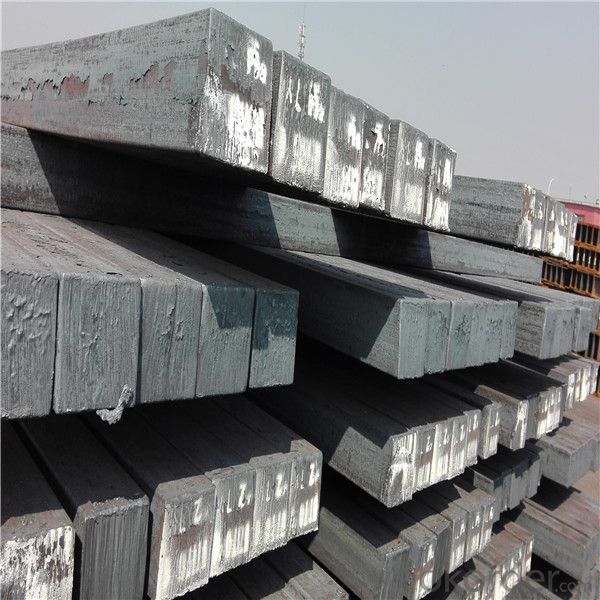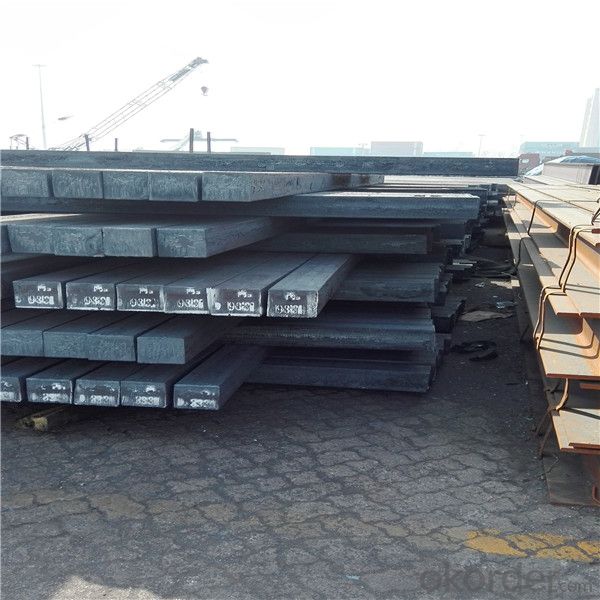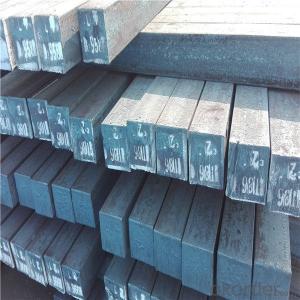Hot rolled square steel billet prime steel
- Loading Port:
- Tianjin
- Payment Terms:
- TT OR LC
- Min Order Qty:
- 1000 m.t.
- Supply Capability:
- 29437 m.t./month
OKorder Service Pledge
OKorder Financial Service
You Might Also Like
Item specifice
Steel billet(ingot) by cogging or breakdown of semi-finished products, is the raw material of all kinds of steel mill. Billet section of square, round, flat, rectangular
and abnormity of several kinds of, mainly related to the shape of rolled products.
Rectangular billet continuous casting billet and mainly general carbon steel, low carbon low silicon cold-rolled material, high quality carbon structural steel, high strength low alloy steel, special steel, etc.
The billet is mainly divided into two kinds from the shape:
Slab: cross section width and height of the ratio of the larger, mainly used for rolling plate.
Size :100mm to 165mm
Length:6~12meters
Grade: Q195/Q215/Q235/Q275
Qaulity:own factory, stable quality
Tolerance: Strictly according to the G/B and JIS standard
Gade:
Standard | C(%) | Mn(%) | S(%) | P(%) | Si(%) |
Q195 | ≤0.12 | ≤0.50 | ≤0.040 | ≤0.035 | ≤0.30 |
Q235 | ≤0.20 | ≤1.40 | ≤0.045 | ≤0.045 | ≤0.35 |
Q275 | ≤0.22 | ≤1.50 | ≤0.045 | ≤0.045 | ≤0.35 |
20MnSi | 0.17-0.25 | 1.2-1.6 | ≤ 0.050 | ≤ 0.050 | 0.40-0.80 |
3SP | 0.14-0.22 | 0.40-0.85 | ≤ 0.050 | ≤ 0.040 | 0.05-0.15 |
5SP | 0.28-0.37 | 0.50-1.00 | ≤ 0.050 | ≤ 0.040 | 0.15-0.30 |



Our service :
We have a plant and professional team to provide our best service, from the start of production until the
loading into the vessel, we have a complete quality follow up procedure, to assure our products arrives to the customer with satisfaction. Welcome new and old customers
to contact us for future business relationships! We will give you a surpise price.
Packing :
Within 30 days
1.Standard export package
2.In bundles with steel strips
3.As the requirements of the customers
FAQ:
Q: What is payment terms?
A: FOB 30% T/T IN ADVANCE AS DEPOSIT AND 70% T/T BEFORE SHIPMENT
CIF and CFR 30% T/T IN ADVANCE AS DEPOSIT AND 70% T/T AS THE COPY OF B/L OR L/C AT SIGHT
Q:How to guarantee the quality of the products?
A:We have established the international advanced quality management system,every link from raw material
to final product we have strict quality test;We resolutely put an end to unqualified products flowing into the market.
At the same time, we will provide necessary follow-up service assurance.
Q:How long can we receive the product after purchase?
A :In the purchase of product within three working days, We will arrange the factory delivery as soon as possible.
The pecific time of receiving is related to the state and position of customers.
- Q:How are steel billets inspected for surface finish?
- Steel billets are inspected for surface finish using different methods and techniques to ensure quality and compliance with industry standards. One common method is visual inspection, where trained inspectors visually examine the surface of the billet for any defects such as scratches, pits, cracks, or any other irregularities. This inspection is typically done under proper lighting conditions to enhance the visibility of any imperfections. Another method used is non-destructive testing (NDT), which includes techniques such as magnetic particle inspection (MPI) and liquid penetrant inspection (LPI). MPI involves applying a magnetic field to the billet and then applying a magnetic particle suspension that will reveal any surface defects by adhering to them. LPI, on the other hand, involves applying a liquid penetrant solution to the surface of the billet, which is then removed and followed by the application of a developer that highlights any defects. Ultrasonic testing (UT) is another commonly used technique for inspecting the surface finish of steel billets. UT utilizes high-frequency sound waves that are transmitted through the billet, and any reflected waves are analyzed to detect any surface or subsurface defects. This method can provide detailed information about the surface condition and can detect even minute flaws. In addition to these methods, surface profilometers can be used to measure the roughness of the billet's surface. These devices use a stylus or laser to measure the height variations on the surface, providing data on the roughness and texture. Overall, steel billets undergo thorough inspection for surface finish using a combination of visual inspection, NDT techniques, and surface profilometry. These inspections help ensure that the billets meet the required surface finish standards and are suitable for further processing or manufacturing.
- Q:How are steel billets used in the production of pipes?
- Steel billets are melted and then cast into a solid form, which is then rolled or forged to form pipes of various sizes and shapes. These billets serve as the raw material for the pipe production process and are essential in ensuring the strength, durability, and structural integrity of the pipes.
- Q:What is the typical size and shape of steel billets?
- The typical size and shape of steel billets can vary depending on the specific application and industry requirements. However, they are commonly rectangular or square in shape, with dimensions ranging from a few inches to several feet in length, width, and height.
- Q:What is the role of steel billets in the production of sheet metal?
- Steel billets play a crucial role in the production of sheet metal as they are the primary raw material used to create thin, flat sheets of metal. These billets are heated, rolled, and shaped through a series of processes to transform them into sheet metal. The quality and composition of the billets directly impact the strength, durability, and overall characteristics of the final sheet metal product.
- Q:What are the different methods of steel billet surface treatment?
- The industry commonly utilizes several methods for steel billet surface treatment, aiming to enhance properties such as corrosion resistance, hardness, and aesthetics. Some of the most widely used methods include: 1. Pickling and Passivation: By utilizing acid solutions, impurities and oxide layers are removed from the steel surface. Passivation follows pickling to create a protective layer against future corrosion. 2. Shot Blasting: This mechanical treatment involves bombarding the billet surface with high-speed steel shots or grits, effectively eliminating scale, rust, and contaminants to achieve a clean and uniform surface. 3. Hot-Dip Galvanizing: Steel billets are immersed in molten zinc, which forms a protective coating on the surface. This method provides exceptional corrosion protection, making it suitable for outdoor applications. 4. Electroplating: A thin layer of metal, such as chrome or nickel, is deposited onto the steel surface using an electric current. This process enhances appearance, corrosion resistance, and wear resistance. 5. Powder Coating: A dry powder is applied to the steel surface and then cured through heat, resulting in a durable and visually appealing finish. This method is popular for aesthetic purposes. 6. Painting: The steel surface is cleaned, primed, and applied with a suitable paint system. This method enhances appearance and provides protection against corrosion and environmental factors. 7. Nitriding: Nitrogen diffuses into the steel surface through a heat treatment process. This method improves billet hardness, wear resistance, and fatigue strength. These are just a few of the available methods for steel billet surface treatment. The choice of method depends on specific application requirements, desired properties, and budget considerations.
- Q:What are the different surface defects found in tool steel billets?
- There are several different surface defects that can be found in tool steel billets. These defects can occur during the manufacturing process or can be the result of handling, transportation, or storage. Some of the common surface defects found in tool steel billets include: 1. Decarburization: This defect occurs when the surface of the steel billet loses its carbon content due to exposure to high temperatures during heat treatment or improper cooling. Decarburization can lead to reduced hardness and wear resistance in the tool steel. 2. Scale: Scale refers to the formation of oxide layers on the surface of the steel billet. It can occur during the hot rolling process or due to exposure to high temperatures. Scale can negatively impact the surface finish and can also affect the mechanical properties of the tool steel. 3. Cracks: Cracks can occur on the surface of tool steel billets due to various reasons such as improper cooling, excessive stress during hot rolling, or quenching. These cracks can be either surface cracks (which are visible) or internal cracks (which may not be immediately visible). 4. Inclusions: Inclusions are non-metallic particles or impurities that are trapped within the steel billet during the manufacturing process. These inclusions can cause weak spots or discontinuities in the material, leading to reduced toughness and fatigue resistance. 5. Pitting: Pitting refers to the formation of small holes or cavities on the surface of the steel billet. It can be caused by localized corrosion, exposure to aggressive environments, or improper handling. 6. Roll marks: Roll marks are surface imperfections that occur due to the contact between the steel billet and the rolls during the hot rolling process. These marks can appear as grooves, scratches, or indentations on the surface of the tool steel. 7. Surface contamination: Tool steel billets can get contaminated with foreign substances such as dirt, oil, grease, or other particles during handling, transportation, or storage. These contaminants can negatively affect the surface finish and can also lead to corrosion or other defects. It is important to detect and address these surface defects in tool steel billets to ensure the desired performance and reliability of the final tooling products. Various inspection techniques and quality control measures are employed to identify and mitigate these defects, such as visual inspection, ultrasonic testing, magnetic particle inspection, and surface cleaning processes.
- Q:What is the role of steel billets in the manufacturing of storage systems?
- Steel billets play a crucial role in the manufacturing of storage systems as they serve as the raw material for the production of various steel components used in these systems. These billets are heated, rolled, and shaped to create beams, columns, and other structural elements that provide strength and stability to the storage systems. Additionally, steel billets can be further processed to create shelves, racks, and other storage components, ensuring durability and reliability in the overall design.
- Q:How do steel billets contribute to the manufacturing of automotive components?
- Steel billets are the starting point for the manufacturing of automotive components as they are heated and shaped into various forms such as rods, bars, and sheets. These billets are strong, durable, and can be easily molded into the desired shape, making them ideal for producing structural automotive parts like engine blocks, chassis, and suspension components. Additionally, steel billets provide the necessary strength and stability required to withstand the harsh conditions and loads experienced by automotive components, ensuring the overall safety and reliability of vehicles.
- Q:Can steel billets be used for making musical instruments?
- Musical instruments can indeed be crafted from steel billets. Although conventional instruments are typically fashioned from wood or brass, steel offers a distinctive and contemporary alternative. The strength and durability of steel render it well-suited for certain instruments, including steel drums and steel guitars. Moreover, steel's adaptability permits the formation of intricate designs and shapes, resulting in a broad spectrum of sounds. Nevertheless, it is crucial to acknowledge that the specific attributes and properties of the steel utilized, such as its composition and thickness, will heavily influence the instrument's sound and quality. Therefore, meticulous consideration and experimentation may prove necessary in order to achieve the desired musical tones and effects when employing steel billets for instrument production.
- Q:How do steel billets contribute to the manufacturing of kitchen appliances?
- Kitchen appliances rely on steel billets as an essential component for their production. These semi-finished steel products, typically rectangular or square in shape, are created through continuous casting. One way in which steel billets contribute to the manufacturing of kitchen appliances is by serving as the primary raw material for various appliance components. Stoves, ovens, refrigerators, and dishwashers require a strong and durable structure, which steel billets provide. Through processes like hot rolling, forging, or extrusion, the billets are transformed into specific parts such as frames, doors, panels, and handles. Steel billets also play a vital role in ensuring the longevity and reliability of kitchen appliances. With its high tensile strength and resistance to corrosion, steel allows manufacturers to create appliances that can withstand daily use and endure for a long time. By using steel billets as the base material, kitchen appliances can handle high temperatures, heavy loads, and harsh environments without compromising their structural integrity. Moreover, steel billets contribute to the aesthetic appeal of kitchen appliances. The smooth and polished surface of steel provides an attractive and modern finish, making appliances visually appealing to consumers. Steel can also be easily manipulated to achieve different shapes and designs, allowing manufacturers to create sleek and stylish appliances that complement the overall kitchen decor. Additionally, steel billets possess excellent heat conductivity properties, which is crucial for kitchen appliances like stoves and ovens. The even distribution of heat throughout the appliance ensures efficient cooking and baking, guaranteeing that food is cooked thoroughly and evenly. In conclusion, steel billets are indispensable in the manufacturing of kitchen appliances due to their strength, durability, aesthetics, and heat conductivity properties. Without these billets, it would be challenging to produce high-quality, reliable, and visually appealing kitchen appliances that meet consumer demands.
1. Manufacturer Overview |
|
|---|---|
| Location | |
| Year Established | |
| Annual Output Value | |
| Main Markets | |
| Company Certifications | |
2. Manufacturer Certificates |
|
|---|---|
| a) Certification Name | |
| Range | |
| Reference | |
| Validity Period | |
3. Manufacturer Capability |
|
|---|---|
| a)Trade Capacity | |
| Nearest Port | |
| Export Percentage | |
| No.of Employees in Trade Department | |
| Language Spoken: | |
| b)Factory Information | |
| Factory Size: | |
| No. of Production Lines | |
| Contract Manufacturing | |
| Product Price Range | |
Send your message to us
Hot rolled square steel billet prime steel
- Loading Port:
- Tianjin
- Payment Terms:
- TT OR LC
- Min Order Qty:
- 1000 m.t.
- Supply Capability:
- 29437 m.t./month
OKorder Service Pledge
OKorder Financial Service
Similar products
New products
Hot products
Hot Searches
Related keywords





























